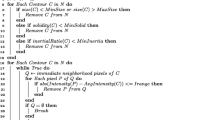Abstract
A novel deformable model for unsupervised segmentation of cervical cells within Pap smear images is presented in this paper. The proposed method is inspired by fluid mechanics and based on the simulation of incompressible fluid flood via grid-based solution of Navier–Stokes equations. In this approach, simulation starts inside the cytoplasmic region and the simulated fluid is attracted toward the cell contours. Unlike most of the other fluid-based methods, gradient magnitude data are not used for extracting topological relief of the image. However, gradient magnitude of the image is still considered as the source for extracting particles. Direction of propagation of the flow is determined by an interaction mechanism based on the permeability rate of these particles. Interaction between fluid and particles guides the advancing fronts of the fluid toward object boundaries. Redefinition of complex topologies with particle groups provides potential of improved segmentation capability and flexibility to the model. We demonstrate the segmentation capability of our model with fully automated and unsupervised experimental setting on Pap smear sample images. Results showed that proposed method may be more adaptive than watershed algorithm and have an improved performance on recovering shape and boundary data of cervical cells.














Similar content being viewed by others
References
Chen, Y., Huang, P., Lin, K., Wang, L., Lin, H., Cheng, C., Chen, T., Chan, Y., Chiang, J.: Semi-automatic segmentation and classification of pap smear cells. IEEE J. Biomed. Health Inf. 18(1), 94–108 (2014)
Papanicolaou, G.N.: A new procedure for staining vaginal smears. Science 95, 438–439 (1942)
Dougherty, D.: Medical Image Processing Techniques and Applications. Springer, New York (2011)
Plissiti, M.E., Nikou, C., Charchanti, A.: Combining shape, texture and intensity features for cell nuclei extraction in Pap smear images. Pattern. Recogn. Lett. 32(6), 838–853 (2011)
Wu, H.-S., Barba, J., Gil, J.: A parametric fitting algorithm for segmentation of cell images. IEEE Trans. Biomed. Eng. 45(3), 400–407 (1998)
Tsai, M.-H., Chan, Y.-K., Lin, Z.-Z., Yang-Mao, S.-F., Huang, P.-C.: Nucleus and cytoplast contour detector of cervical smear image. Pattern. Recogn. Lett. 29(9), 1441–1453 (2008)
Plissiti, M.E., Nikou, C., Charchanti, A.: Watershed-based segmentation of cell nuclei boundaries in Pap smear images. In: Proceedings of IEEE International Conference on Information Technology and Applications in Biomedicine, pp. 1–4 (2010)
Xu, C., Prince, J.L.: Generalized gradient vector flow external forces for active contours. Signal Process 71(2), 131–139 (1998)
Chan, T.F., Vese, L.A.: Active contours without edges. In: Proceedings of IEEE International Conference on Image Processing, pp. 266–277 (2001)
Williams, D.J., Shah, M.: A fast algorithm for active contours and curvature estimation. CVGIP Imag. Underst. 55(1), 14–26 (1992)
Bamford, P., Lovell, B.: Unsupervised cell nucleus segmentation with active contours. Signal Process 71(2), 203–213 (1998)
Floyd, R.W.: An adaptive algorithm for spatial gray-scale. Proc. Soc. Inf. Disp. 17, 75–77 (1976)
Cardon Cline, D., Egbert, P.K.: Fluid flow for the rest of us: tutorial of the marker and cell method in computer graphics (2014). http://www.proxyarch.com/util/techpapers/papers/Fluidflowfortherestofus
Stam, J.: Real-time fluid dynamics for games. In: Proceedings of the Game Developer Conference, pp. 18–25 (2003)
Jalba, A.C., Roerdink, J.B.T.M.: A physically-motivated deformable model based on fluid dynamics. In: Computer Vision – ECCV 2006, pp. 496–507. Springer, Heidelberg (2006)
Lipkus, A.H.: A proof of the triangle inequality for the Tanimoto distance. J. Math. Chem. 26(1–3), 263–265 (1999)
Kurugollu, F., Sankur, B., Harmanci, A. E.: Color image segmentation using histogram multithresholding and fusion. Image Vis. Comput. 19(13), 915–928 (2001 )
Acknowledgments
The authors would like to thank Prof. Dr. Seyda Erdogan of Cukurova University for their valuable support. This study was granted by the Cukurova University Research Foundation.
Author information
Authors and Affiliations
Corresponding author
Rights and permissions
About this article
Cite this article
Cengizler, C., Guven, M. & Avci, M. A fluid dynamics-based deformable model for segmentation of cervical cell images. SIViP 8 (Suppl 1), 21–32 (2014). https://doi.org/10.1007/s11760-014-0719-3
Received:
Revised:
Accepted:
Published:
Issue Date:
DOI: https://doi.org/10.1007/s11760-014-0719-3




